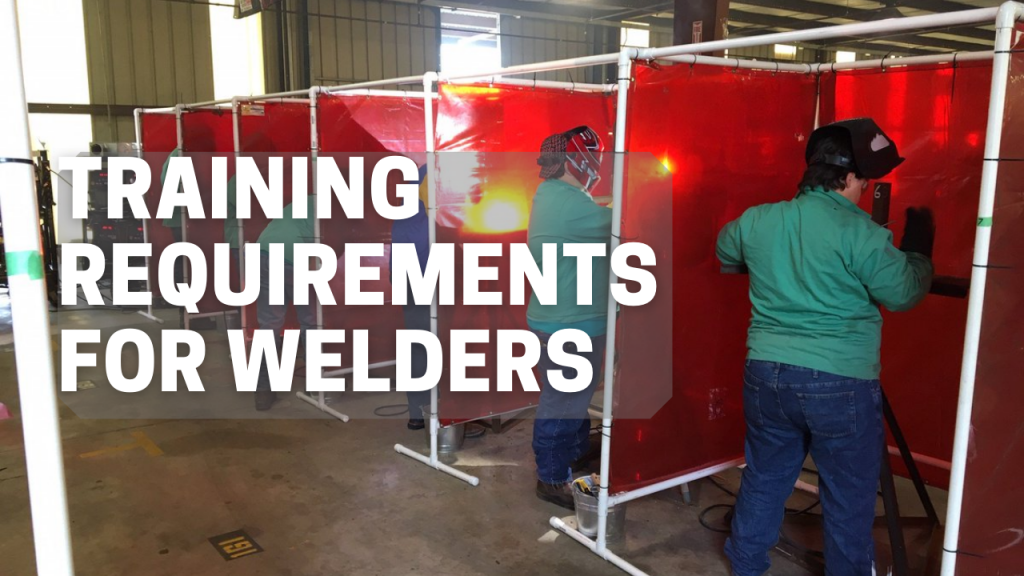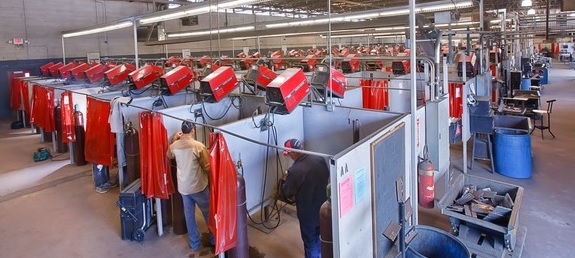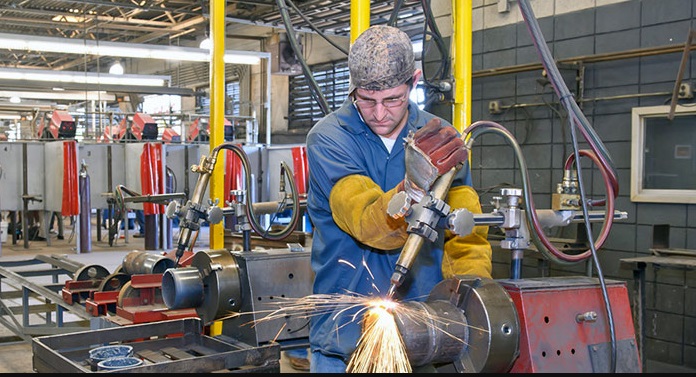If you enjoy working with your hands and building things, welding is the perfect career for you. Welders help build and repair everything from the smallest cars to the most powerful ships. But to do this, you have to go through a welding school program to learn how to practice this profession.
If you’re wondering what the field is like, industry and government sources say the welder’s needs and salaries are healthy. Qualified welders are in high demand as they are still in short supply. The Bureau of Labor Statistics estimates the median wages for welders, cutters, solder, and solder at $ 39,390, but the top 10% earn more than $ 62,100.

WHAT ARE WELDING SCHOOL PROGRAMS LIKE?
Attending a welding school program means spending a lot of time at the welding shop. They are primarily practical programs designed to provide you with the technical skills you need to make your trade. You can only acquire these skills through practice.
Depending on the program’s exact composition, you may also learn skills related to a specific industry or general “soft skills.” These can include:
This means taking a few classes and spending some time studying. You will likely find it easier to motivate yourself to do this than in high school. The subjects you study are closely related to your skills and will help you in your career.
TRAINING REQUIREMENTS FOR WELDERS

Welding training requirements vary depending on the employer. Some employers require welders to graduate from high school and complete welder tests on an employed basis. Other employers are looking for a certificate or bachelor’s degree from a technical school, vocational school, or community college. Welders can also learn techniques through weld gauges.
Welding courses can result in a Welding Certificate, Associate of Science in Welding, or Bachelor of Science in Welding Engineering. Formal education programs can last from a few weeks to a few years.
Students on a welding program learn the art of heating and shaping metals. Required lessons may include advanced math, metallurgy, blueprint reading, welding symbols, pipe assembly, and a welding internship.
Methods and techniques taught in welding classes include arc welding, brazing, brazing, casting, and tanning. Practical training often includes oxy-fuel welding and cutting, gas shielded welding, gas-tungsten arc welding, and gas-metal arc welding.
Relevant Read: Best welding helmet in 2023
CAREER INFORMATION

Building a successful welding career requires good hand-eye coordination and manual dexterity, communication skills, and problem-solving skills. Possible careers include welding inspector, processor, welding salesperson, welding teacher, supervisor, welding engineer, and foreman. The career opportunities for welders with more expertise and training can be expanded.
Training in the latest technology is just as necessary as being willing to relocate. According to the U.S. Department of Labor Statistics, welders earned an average hourly wage of $ 21.33 per hour in May 2018. Job prospects for welders will increase by three percent between 2018 and 2028.
Certification can be done independently or through AWS accredited welding programs. Employers can also conduct their internal certification tests. Welding professionals usually work a minimum of 40 hours a week in workshops, factories, or construction sites.
Due to welding’s hazardous nature, safety training and supervision are required before a welder can work independently on site. Work experience is just as essential and is usually gained through several years of internship.
Relevant Read: Best Welding Helmets for Beginners
WHAT DO YOU LEARN DURING YOUR WELDING SCHOOL PROGRAMS?

A formal welding school provides solid education that includes technical and “soft” skills to help students succeed in the workplace. Think of it as a right mix of theory, technical expertise, and practice – lots of practice. :
Welding plates and pipes in different positions and conditions
In the real world, you can seldom choose the position for welding. So don’t be surprised if you find yourself in a rather uncomfortable, uncomfortable, and narrow space. In a welding program, you will learn how best to approach different welding positions and what techniques must be used in each position to make the welds safe and efficient.
Lessons in the extensive welding process
One of the significant advantages of a formal educational process over trying to learn on the job is that you aren’t just learning to weld in one processor for a job. Instead, primary welding schools will teach students all four major welding processes: GMAW, GTAW, SMAW, and Flux Core Arc Welding. Different industries will use different processes, and learning all of the processes will make students more informed and diverse once they enter the job market.
Important industry-related soft skills
Success in the workplace requires more than just the ability to make good welds. In most welding careers, you will work with others, but you will also be expected to work independently.
During a formal welding program, students also encounter classes that help them develop skills to communicate clearly about technical assignments, write and read technical parts that describe what a job involves, and how best to get in one Group welding project is working.
Some programs teach industry-related skills
Skills such as service management, technical writing, communication, or theory about a particular industry can open many career trails for you. Some courses teach these skills to assistance you move forward in your career if you ever want the opportunity to advance to a higher position.
Advanced math
To expand this technical writing, students must be ready to develop and improve their math skills. Welders need to have a solid understanding of fractions, decimals, geometry, and trigonometry because welding often involves measuring angles and cutting pipes and welding them with the right seams to make healthy joints.
Relevant Read: ESAB SENTINEL A50 WELDING HELMET
HOW TO ENROLL FOR A WELDING SCHOOL PROGRAM?

A person’s most important trait or development before signing up for a formal welding program is the dedication to practice. Most programs have opening hours and long class hours that allow you to practice different welds and processes. Some students come in and use this time to socialize or do something other than practice.
However, spend every extra minute practicing and building on those welding fundamentals. You will develop both solid welding skills and the recognition your professors desire in making these early-career recommendations.
Keep in mind that the first time he tried, Michael Jordan was not on the college basketball team, but after failing, he rose to fame – from then until the end of his career – for being the first in the gym to train, and the last to go.
If you have the same kind of dedication all your time in welding school, you will also stand out from the crowd.
Relevant Read: BEST BUDGET WELDING HELMETS UNDER $100
WHICH WELDING JOBS ARE AVAILABLE FOR EACH LEVEL?

A single welding certification qualifies you for an entry-level job as a welder. However, it would be best to have multiple certificates and work experience before you can take on a supervisory role.
- If you have multiple certifications associated with one degree, you are more useful than someone with one certificate. It also puts you on the fast track to better jobs in the field.
- With some documented work experience and qualifications, you can become a supervisor, welding inspector, teacher, or trainer.
- All of these positions give you more responsibility and a better salary.
- Good welders with multi-weld certification are also the most obvious candidates to learn how to manage, maintain, program, and operate robotic welds.
- These robotic units are extensively seen as an answer to the shortage of skilled welders and could be in high demand for years to come.
Relevant Read: BEST WELDING HELMETS FOR MIG
USEFUL INFORMATION IF YOU WANT TO STUDY WELDING
Studying welding in college can significantly enhance your career and skills, especially if you have a role as a welding engineer or welding inspector in mind. However, rising wages and responsibilities are not without their obstacles. If you want to study welding, there are six things you need to know in advance.
Welding is unlike any other major in college
When you study welding in college, you have a lot more hands-on work than most other majors. You will spend a lot of time improving your skills and perfecting the profession.
Welding courses consist of two parts: the first takes place in the classroom, where you study the pros and cons of welding to understand what’s going on. The other is called “Laboratory” and takes place in a workshop.
This is where you use the welding equipment. This is great for those who would instead use their hands than spend their entire school experience in a book like many majors do.
However, this also means that you cannot skip the lesson and expect to pass with flying colors. Even if you know the skills, most professors keep track of who comes to the labs.
Relevant Read: TIG WELDING STAINLESS STEEL
What is included in the practical work?

They know that using a welder is not the same as using a mixer. You don’t change the settings, and then you press a button. You use the lab time to apply what you’ve learned in class and figure out how small details, such as angles, can be combined with your skills to create the perfect bead.
Depending on your university, the “hands-on” work may also include several certification exams. Even if not, the skills you learn in college will allow you to pass many of the various certification exams yourself.
What does learning books have to do with welding?
If you know the theories and principles of welding, you have one leg up. Understanding why a change in voltage affects current can help predict problems before they occur. It also means that you can explain these issues to other people who otherwise wouldn’t understand them.
How will you be assessed?
During the class, you will take tests based on what you have learned from the book and the professor. In your laboratories, you will receive several parameters and conditions for a project. Your welding will then be based on the AWS Standards (American Welding Society) for appearance, completion, and project parameters compliance.
How long does it take to learn to be a welder?
Depending on the school, welding courses may last just a few weeks or take up to six months to complete. They cover welding theory and welding basics so that students can begin working as soon as they graduate. In addition to reading blueprints and completing work orders, they will learn how to safely use welding equipment.
Relevant Read: Top 10 Best TIG Welders
ADVANTAGES OF THE WELDING SCHOOL
There are many ways to learn to weld, but some positions require a college degree. Without college experience, you need at least 12 years of work experience to become a welding engineer or a welding inspector.
The college also gives you the general knowledge needed to make you more attractive: B. Understanding the costs or communicating with all non-welders involved in a project (mechanical/electrical engineers, financiers, etc.).
CONCLUSION
Studying welding is not easy – like any other college degree. You will have to work for it. But it’s worth it, especially if you are serious that welding is more than just a job; it’s a real career. Familiarize yourself with power tools such as a grinder and prepare for the heat. If you choose to weld, be proud.
Welders – and welding engineers and managers – are just as needed as mechanical engineers or electrical engineers. Your skills make a huge difference between the success or failure of a project.